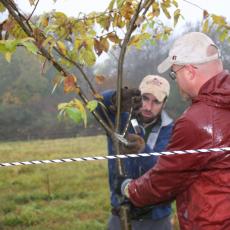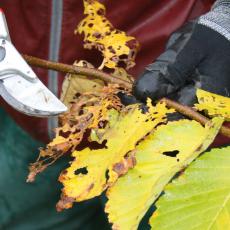Rick Harper says American elm trees are tough, which make them a great choice for urban locations. The heartiness of this tree is demonstrated by the success found at a one-acre elm orchard at the Agricultural Learning Center at the north edge of the UMass Amherst campus. These saplings have survived severe drought, abnormally wet conditions, deer munching, and feeding injury from gypsy moth and Japanese beetle. Still, about 80% of the 220 seedlings are thriving.
On a recent rainy fall day, Harper, extension associate professor of urban forestry, Nick Brazee, extension plant pathologist and undergrad Tara McElhinney (’19), were hard at work transplanting saplings germinated in a UMass greenhouse. They also spent some time strategically pruning mature taller trees to help them grow into the classic “vase” shape. This was a highly-prized attribute seen in these giants before Dutch elm disease changed the beauty of many main streets in New England’s urban and small-town landscapes. McElhinney says, “This project has become important to me. I planted many seedlings and have watched them grow and thrive. It’s gratifying to think I might be part of a resurgence of healthy elms throughout the northeast.”
Researchers like Harper and Brazee are working hard to identify resistant genotypes with the hope of one day being able to provide suitable replacements for cities and towns in the future. Imagine going back the future with elegant elm-lined streets once again.



